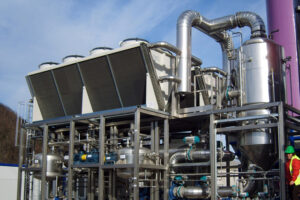In industries where strength, corrosion resistance, and durability are critical, the choice of fittings can significantly impact operational efficiency and safety. Among the best options available today are duplex forged fittings — known for their superior mechanical properties and excellent resistance to harsh environments. These fittings are a preferred choice in the oil & gas, petrochemical, marine, and power generation industries.
What Are Duplex Forged Fittings?
Duplex forged fittings are pipe connectors manufactured from duplex stainless steel and produced through the forging process. Duplex stainless steel is a unique alloy that combines the properties of both austenitic and ferritic stainless steel, resulting in a material that offers higher strength and better corrosion resistance than standard stainless steel.
The forging process involves shaping the steel using compressive forces at high temperatures, which refines the grain structure and enhances the strength of the metal. The result is a durable, high-performance fitting that can withstand pressure, stress, and corrosive elements.
Key Properties of Duplex Stainless Steel
The core reason for the popularity of duplex stainless steel lies in its balanced microstructure, consisting of nearly equal parts of ferrite and austenite. This balance gives duplex steel the following properties:
-
Excellent corrosion resistance: Particularly against stress corrosion cracking and pitting.
-
High strength: Roughly twice as strong as regular austenitic stainless steel grades like 304 and 316.
-
Improved weldability: While not as easy to weld as austenitic grades, duplex steel offers better weldability than ferritic grades.
-
Cost-effective: Due to its high strength, thinner sections can be used without compromising durability.
These qualities make duplex forged fittings an ideal solution for demanding applications where standard fittings might fail over time.
Types of Duplex Forged Fittings
Duplex forged fittings are available in a wide variety of types and configurations to suit different piping systems. Common types include:
-
Socket Weld Fittings: Ideal for small-diameter, high-pressure systems.
-
Threaded Fittings: Suitable for non-welded systems, commonly used in low-pressure applications.
-
Elbows, Tees, Couplings, Unions: Essential for changing flow directions, connecting pipes, and disassembling sections.
Each fitting type is designed to meet specific piping requirements and is manufactured according to international standards such as ASTM, ASME, and ANSI.
Applications of Duplex Forged Fittings
Thanks to their superior characteristics, duplex forged fittings are widely used across numerous industries:
-
Oil & Gas Industry: Used in upstream, midstream, and downstream applications due to their resistance to chloride stress corrosion.
-
Chemical & Petrochemical Plants: Handle aggressive fluids and elevated temperatures with ease.
-
Desalination Plants: Withstand high salinity levels without degradation.
-
Marine Applications: Ideal for shipbuilding, offshore platforms, and sea water cooling systems.
-
Power Generation: Useful in both nuclear and thermal power plants for high-stress and corrosive areas.
In these applications, the use of high-performance materials such as duplex steel ensures long service life and reduced maintenance, leading to lower overall operating costs.
Benefits of Using Duplex Forged Fittings
When choosing piping components, the benefits of duplex forged fittings cannot be overstated:
-
Superior strength and fatigue resistance
-
Long-term corrosion resistance, even in aggressive environments
-
Greater lifecycle cost efficiency compared to traditional stainless steels
-
Reliable performance under high pressure and fluctuating temperatures
Their robustness makes them a trusted choice in mission-critical systems where failure is not an option.
Why Duplex Forged Fittings Are a Smart Investment
Choosing the right fitting for a piping system is crucial for maintaining performance, safety, and regulatory compliance. Duplex forged fittings offer a unique blend of strength, corrosion resistance, and cost-effectiveness. Their use can enhance system integrity, reduce the risk of leaks and failures, and extend the lifespan of the infrastructure.
As industries continue to demand more from their materials and components, duplex stainless steel fittings are proving to be a smart, future-ready solution for complex piping networks.
How Duplex Forged Fittings Compare with Other Fittings
When selecting piping components, engineers often compare duplex forged fittings with other popular materials like carbon steel, standard stainless steel (304/316), and even nickel alloys. One of the most striking differences lies in duplex steel’s ability to resist chloride-induced stress corrosion cracking—something 304 or 316 stainless steel struggles with in highly saline or acidic environments.
Additionally, duplex forged fittings offer significantly higher yield strength—almost double compared to standard austenitic grades. This allows the use of thinner wall sections, reducing overall material weight without compromising performance. This is particularly useful in large-scale projects such as offshore rigs and chemical processing plants, where weight and space are critical design considerations.
In contrast to carbon steel, duplex stainless offers far better corrosion resistance and lower maintenance costs. While carbon steel might seem cost-effective initially, the added costs of corrosion protection, frequent inspections, and replacements can quickly outweigh the savings.
Quality Standards and Certifications
To ensure reliable performance in critical applications, duplex forged fittings must conform to strict industry standards. These include:
-
ASTM A182 – Standard specification for forged or rolled alloy and stainless steel pipe flanges, forged fittings, and valves.
-
ASME B16.11 – Covers dimensions and tolerances for forged steel fittings.
-
NACE MR0175 – Specifies material requirements for sour gas environments in the oil and gas sector.
Certified manufacturers conduct rigorous quality checks, including hydro testing, PMI (Positive Material Identification), ultrasonic testing, and visual inspection to ensure dimensional accuracy and material integrity. Always source fittings from certified suppliers who follow international quality protocols.
Sustainability & Environmental Considerations
Duplex stainless steel is 100% recyclable, making duplex forged fittings a sustainable choice for environmentally-conscious projects. Its long life span also means less frequent replacements, reducing industrial waste and contributing to a lower carbon footprint over the lifecycle of a facility.
Final Thoughts
Duplex forged fittings are more than just components in a piping system—they’re critical for maintaining the safety, reliability, and efficiency of entire operations. With their excellent corrosion resistance, high strength, and long service life, these fittings offer unmatched value across various demanding industries.
Whether you’re dealing with aggressive chemical media, seawater exposure, or high-pressure steam, investing in high-quality duplex forged fittings ensures long-term performance and peace of mind.



